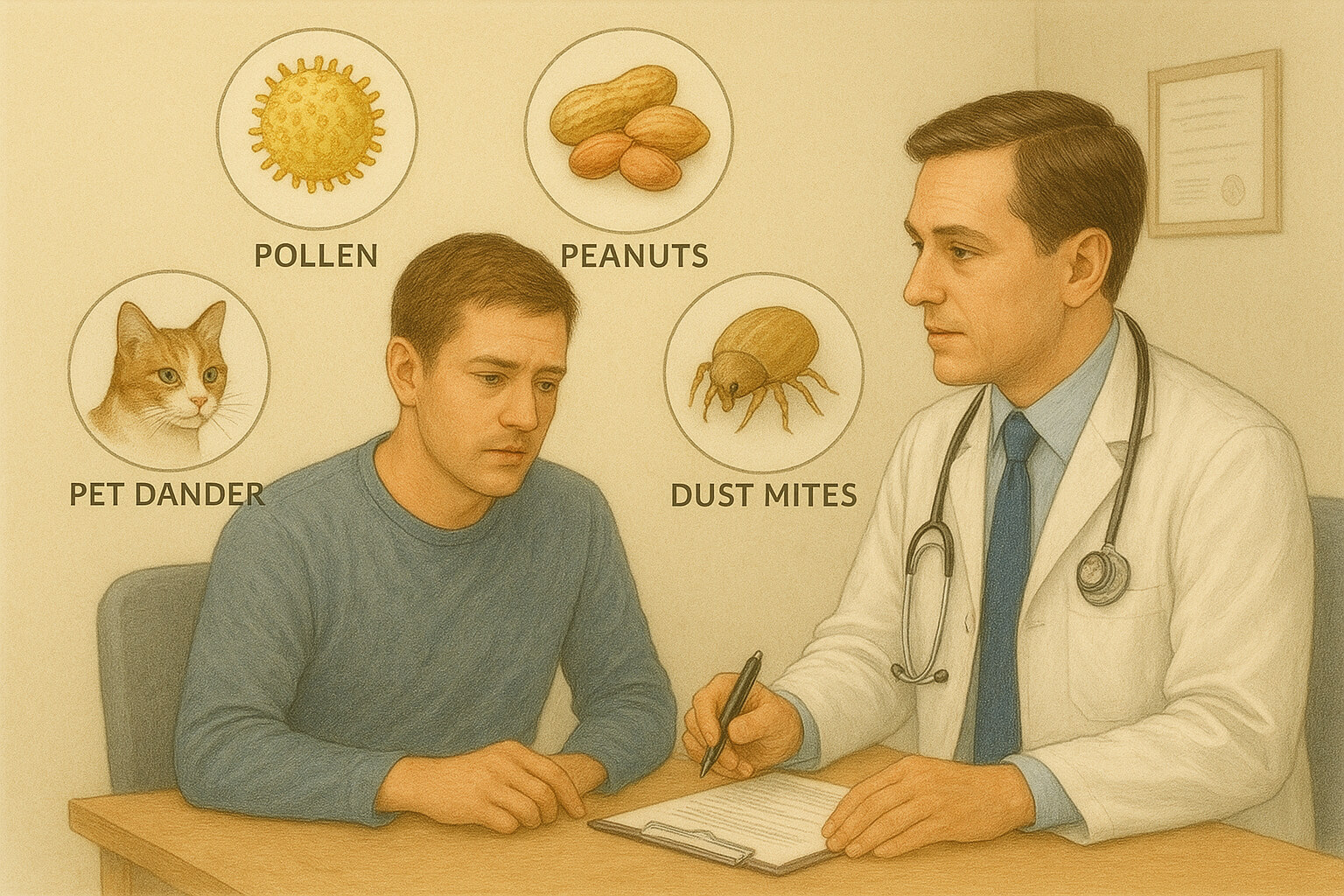Understanding Different Types of Allergies

Allergies are among the most common chronic conditions worldwide, affecting people of all ages and backgrounds. These reactions occur when the body’s immune system mistakenly identifies a harmless substance—known as an allergen—as a threat. In response, it triggers a defense mechanism that can lead to a range of symptoms, from mild irritation to life-threatening complications.
Understanding the types of allergies, their specific triggers, and how to manage them is crucial for improving health, comfort, and safety in everyday life.
Common Types of Allergies
1. Seasonal Allergies (Hay Fever)
- Also called allergic rhinitis, seasonal allergies flare up at certain times of the year, typically during spring and fall when plants release pollen. These allergens are carried through the air and easily inhaled, leading to symptoms like:
- Sneezing fits
- Runny or stuffy nose
- Itchy or watery eyes
- Fatigue due to disturbed sleep
- While these symptoms might seem mild, they can significantly impact quality of life—interfering with work, school, and even sleep. Seasonal allergy sufferers often plan their outdoor activities around pollen forecasts and rely on medications to manage flare-ups.
- Explore more on nature’s impact on health in How to Reduce Your Water Usage at Home & Have an Eco-Friendly Garden.
2. Food Allergies
- Food allergies are among the most serious types, as even small exposures to an allergen can lead to intense and sometimes fatal reactions. Common trigger foods include:
- Peanuts and tree nuts
- Milk and dairy products
- Eggs
- Shellfish and fish
- Wheat and soy
- Symptoms can appear within minutes and may include hives, swelling, nausea, difficulty breathing, or anaphylaxis, which is a rapid and potentially fatal reaction requiring immediate emergency treatment. People with food allergies must read ingredient labels carefully and sometimes carry epinephrine auto-injectors (EpiPens) for safety.
- Learn more about food-related health challenges in What is Food Insecurity and Who Does It Affect.
3. Pet Allergies
- Pets bring love and companionship, but for some people, they can also be a source of allergic reactions. Contrary to popular belief, the main issue isn’t pet hair, but proteins found in dander (dead skin cells), saliva, and urine.
- Exposure can lead to:
- Sneezing or runny nose
- Itchy, red, or watery eyes
- Asthma flare-ups or breathing difficulties
- Skin rashes in some cases
- People with pet allergies often find it difficult to balance their love for animals with their health needs. In many cases, they may need to take preventive measures such as using air purifiers or creating pet-free zones in the home.
- For more on balancing pet ownership and responsibility, see Why Animal Adoption is the Best Option.
4. Dust and Mold Allergies
- Indoor allergies caused by dust mites or mold are persistent and often misunderstood. Dust mites are microscopic organisms that thrive in warm, humid environments—particularly in bedding, upholstery, and carpets. Mold, on the other hand, grows in damp places like bathrooms, basements, or poorly ventilated areas.
- Symptoms may include:
- Persistent coughing or sneezing
- Postnasal drip
- Nasal congestion or sinus pressure
- Skin irritation or eczema-like rashes
5. Insect Sting Allergies
- For many people, an insect sting from a bee, wasp, or hornet causes only mild pain, redness, and swelling. However, for others, it can trigger severe allergic responses. These are often unpredictable and may escalate with each exposure.
- Signs of a serious allergic reaction can include:
- Hives or skin flushing
- Swelling in the face or throat
- Chest tightness or wheezing
- Anaphylaxis, which requires immediate medical care
6. Drug Allergies
- Allergic reactions to medications can range from mild skin irritations to serious, life-threatening symptoms. Common drug-related allergens include:
- Penicillin and other antibiotics
- Aspirin and nonsteroidal anti-inflammatory drugs (NSAIDs)
- Chemotherapy drugs
- Anesthesia agents
- People may experience symptoms like rashes, itching, fever, or breathing problems. It’s essential to report any suspected reaction to a doctor and wear medical ID if a drug allergy is confirmed.
Managing Allergies: Practical Tips for Everyday Life
While allergies can’t always be cured, they can be effectively controlled through a combination of strategies:
- Avoiding known allergens is the first line of defense. This could mean adjusting your diet, making changes at home, or modifying travel plans.
- Medications like antihistamines, corticosteroids, and decongestants help reduce symptoms. For severe reactions, epinephrine is a life-saving treatment.
- Allergy testing—such as skin tests or blood tests—can help identify specific triggers.
- Allergy shots (immunotherapy) may provide long-term relief for certain individuals by gradually desensitizing the immune system to specific allergens.
- Lifestyle adjustments, like using HEPA air filters, cleaning bedding frequently, or managing diet, are essential to minimize everyday exposure.
If you're looking to adopt a holistic view of health, check out Holistic Approaches to Well-being: Mind, Body, Spirit.
Why Allergy Awareness Is Important
Being aware of the different types of allergies—and recognizing their signs—can make a critical difference in preventing complications. Allergies are not just seasonal inconveniences; they can impact sleep, nutrition, social life, and even mental health.
Educating yourself, seeking proper medical support, and staying prepared can help you take control of your allergies rather than letting them control you. Whether you're managing your own condition or supporting someone else, knowledge is the first step toward safer, healthier living.
